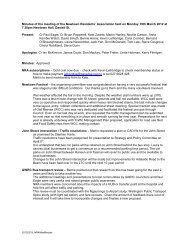Draft Town Belt Management Plan - Wellington City Council
Draft Town Belt Management Plan - Wellington City Council
Draft Town Belt Management Plan - Wellington City Council
Create successful ePaper yourself
Turn your PDF publications into a flip-book with our unique Google optimized e-Paper software.
10<br />
F3 Investigate opportunities to develop forest sinks with other councils to meet respective<br />
ETS obligations.<br />
<strong>Council</strong> operations<br />
C4 Develop a policy to manage carbon credits and obligations.<br />
C5 Investigate development tools that encourage energy efficiency, quality urban design and<br />
built environment.<br />
<strong>Wellington</strong> <strong>City</strong> District <strong>Plan</strong><br />
This is the <strong>Council</strong>’s principal regulatory document setting out objectives and policies, methods<br />
and rules for managing the city environment, land uses and associated activities.<br />
The <strong>Wellington</strong> <strong>City</strong> District <strong>Plan</strong> is prepared in accordance with the Resource <strong>Management</strong> Act<br />
1991 and is based on the principles of sustainability:<br />
• Dependency: All life depends on the health of the natural environment.<br />
• Irreversibility: Some actions can result in permanent loss of species, landforms and<br />
heritage.<br />
• Diversity is necessary in both natural and urban environments. It can enable<br />
communities to adapt to change.<br />
• Efficiency in the use of renewable and non-renewable resources.<br />
• Finite resources: recognition that all resources are finite.<br />
• Equity in access to and the use of resources. Includes enabling communities to care for<br />
their environment and influence change.<br />
• Precautionary approach should be taken where there is uncertainty and potential for<br />
significant harm.<br />
The <strong>Wellington</strong> <strong>Town</strong> <strong>Belt</strong> is identified as a separate open space area Open Space C (Inner <strong>Town</strong><br />
<strong>Belt</strong>) in the <strong>Wellington</strong> District <strong>Plan</strong>. The District <strong>Plan</strong>’s policies, objectives and rules will relate to<br />
the management plan. In particular the District <strong>Plan</strong> proposes to:<br />
16.5.1.2 Recognise the special status of the Inner <strong>Town</strong> <strong>Belt</strong> as public recreation land held in<br />
trust by the <strong>Council</strong> under the <strong>Town</strong> <strong>Belt</strong> Deed 1873 and identify that land on the<br />
District <strong>Plan</strong> maps.<br />
16.5.1.3 Manage the impacts of activities in the Inner <strong>Town</strong> <strong>Belt</strong> in order to protect and preserve<br />
its special qualities for the benefit of future generations.<br />
In addition to policy guidance the District <strong>Plan</strong> has rules for <strong>Town</strong> <strong>Belt</strong> land. The rules allow the<br />
<strong>Council</strong> to exercise control on the type of building and activity that occurs, and this control is<br />
exercised by way of the resource consent process. The rules reflect the status of the <strong>Town</strong> <strong>Belt</strong>, but<br />
have not been reviewed since the District <strong>Plan</strong> became operative in 2000. A review of all Open<br />
Space rules (including the <strong>Town</strong> <strong>Belt</strong> / Open Space C rules) is currently programmed as a high<br />
priority review in the District <strong>Plan</strong> work programme. Notification of a plan change for this area is<br />
scheduled in the 2013–14 financial year. This will provide an opportunity to amend the policies and<br />
rules if it is determined they are no longer considered fit for purpose.<br />
<strong>Draft</strong> Leases Policy for Community and Recreation Groups (under review)<br />
The <strong>Council</strong> provides leases of land and/or buildings at a subsidised rental to a wide range of<br />
community and recreation groups (groups). As <strong>Council</strong>-owned land and buildings are a limited<br />
resource, the <strong>Council</strong> needs to allocate this resource in a way that maximises the use of its assets<br />
and responds to changing demands.<br />
<strong>Draft</strong> <strong>Town</strong> <strong>Belt</strong> <strong>Management</strong> <strong>Plan</strong> October 2012





